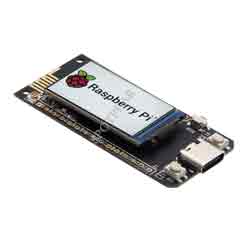- sales/support
Google Chat: zj734465502@gmail.com
- sales
+86-0755-88291180
- sales01
sales@spotpear.com
- sales02
dragon_manager@163.com
- support
tech-support@spotpear.com
- CEO-Complaints
zhoujie@spotpear.com
- sales/support
WhatsApp:13246739196
Raspberry Pi Pico T-PicoC3 User Guide
Note
In TYPE-C, you can determine whether the current connection is PICO or ESP32C3 through positive and negative access.
When connecting, the onboard LED light will indicate according to the connected chip (due to cable problems, the indicator light may be opposite to the actual connected chip, or even two LEDs are on at the same time, please replace the other one when the two LEDs are on at the same time. A cable), the main judgment is that the serial port name shows the currently connected device.
RP2040
Arduino
- Open up the Arduino IDE and go to File->Preferences.
- Unofficial libraries are used in the Arduino examples.In the dialog that pops up, enter the following URL in the "Additional Boards Manager URLs" field:
https://github.com/earlephilhower/arduino-pico/releases/download/global/package_rp2040_index.json
- Go to Tools->Boards->Board Manager in the IDE
- Type "pico" in the search box and select "Add":
- Copy TFT_eSPI to the <C:\Users\Your User Name\Documents\Arduino\libraries> directory
- Open Arduino IDE, find TFT_eSPI in the file and example, the T-Display factory test program is located at TFT_eSPI -> FactoryTest, you can also use other sample programs provided by TFT_eSPI
- In the Arduino IDE tool options, select the development board Raspberry Pi Pico, Other keep the default
- Hold down the BOOT button, click the reset button, and release the BOOT button after a delay of one second or after waiting for the computer to eject a new disk
- Finally, click upload or drag the firmware to the new disk
MicroPython
- install Thonny Python IDE
- After the installation is complete, you need to click on the toolbar, click Run -> Select Interpreter, enter the following interface, select Raspberry Pi Pico, you need to configure Pico before configuring the following ports
- Press the BOOT button, click RES, then go back to Thonny Python IDE and change the port to the serial port where Pico is located. If you don't find it, click Install or update firmware.
- Enter or save as a script to run
from machine import Pin, Timer led = Pin(25,Pin.OUT) tim = Timer() def tick(timer): global led led.toggle() tim.init(freq=2.5, mode=Timer.PERIODIC, callback=tick)
- If you need to save to the chip, you need to click File->Save As->rp2040.
- For more usage methods, please refer to the Micro python documentation.
ESP32-C3
Arduino
- Open up the Arduino IDE and go to File->Preferences.
- In the dialog that pops up, enter the following URL in the "Additional Boards Manager URLs" field:
- Stable release link:
https://raw.githubusercontent.com/espressif/arduino-esp32/gh-pages/package_esp32_index.json
- Development release link:
https://raw.githubusercontent.com/espressif/arduino-esp32/gh-pages/package_esp32_dev_index.json
- Go to Tools->Boards->Board Manager in the IDE
- Type "ESP32C3 Dev" in the search box and select "Add":
- Click any "file-> example-> all esp32 esamle" and upload the run
ESP32-C3 Upload method
- ESP32C3 mainly uses ESP32-AT firmware here. If you want to use it as a coprocessor, you can modify the firmware.
Method 1: if the serial port is displayed with the word jatg when connecting to USB, you can upload it directly using USB. (please note that do not use USB pins to define other functions, otherwise it will be troublesome to upload next time).Method 2: (if there is no serial port when connecting ESP32C3 USB) disconnect USB, short connect ESP32C3-IO9 and GND, and then reconnect USB (note that ESP32C3 device is selected to connect USB).
.jpg)
TAG:
UART To WiFi
Modbus RTU
Raspberry Pi 1.54inch OLED
ESP32 H2 ESP32-H2-Zero MINI Development Board For BLE/Zigbee/Thread
Argon Neo 5
Raspberry Pi Pico 2 RP2350B 2.41 inch AMOLED Development Board QSPI Display TouchScreen 450x600 RM690BO FT6336 QMI8658
Raspberry Pi 0.85inch LCD
Tutorial
Raspberry Pi LCD Display Screen 1.3inch LCD with Game Button AND Audio Buzzer For Zero 2W / 3B / 4B / PI5 / RP2040-PiZero
Mechanical Keyboard
PC U
ESP32 Thermal imaging camera
Sensor Development Board
LuckFox Pico
ESP32-S3
Pan-Tilt Kit
ESP32 C3
GC9107
Raspberry Pi 10.85 inch e-Paper ink screen display black white 1360×480 For Arduino /Jetson /STM32 /ESP32
ESP32 1.54inch OLED
TAG:
VisionFive2
MP1G POE RTL8111 Raspberry Pi 5 PCIe 1G Gigabit Ethernet HAT Pi5
JLINK OB
Raspberry Pi 5 inch LCD 720x1280 Capacitive TouchScreen Display
Raspberry Pi 5 Aluminium Case
AS7341 Spectral Color Sensor Visible Spectrum Sensor
2.13Inch E-Paper
Industrial Modbus POE ETH 8 ch Relay B RTU Modbus TCP-Ethernet Digital Input PoE Power IOT
Arduino Atmega328P Nano
Raspberry Pi 5 PD Activation Module
Raspberry Pi DS3231
Raspberry Pi 5 802.3af
Raspberry Pi 7 inch DSI LCD C Case A Display MIPI 1024x600 Capacitive TouchScreen
Raspberry Pi 5 Copper Heatsink Option Fan or No-Fan
Pi5 Fan
CPU Monitor Display
Raspberry Pi 15.6 inch FHD Monitor LCD Capacitive TouchScreen Display Type-C HDMI Computer PC
Raspberry Pi Pico 2 RP2350B 2.41 inch AMOLED Development Board QSPI Display TouchScreen 450x600 RM690BO FT6336 QMI8658
Raspberry Pi 5 Aluminum Case
Raspberry Pi 5 9layer Case




